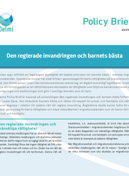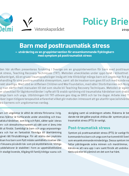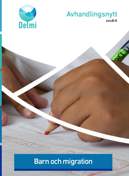The report attempts to answer questions about the unaccompanied minors' entry into the Swedish labor market using register data for those who received a residence permit in Sweden 2003–2014. What kind of professions do they have? And how many neither study nor work? How are the unaccompanied minors' establishment in the labor market affected by age, gender, country of origin, time in Sweden, where in Sweden they have settled, and possible reunification with their parents. The report begins with a historical overview of the migration of unaccompanied refugee children to Europe and with a brief review of results from previous international research in the field. Then basic facts about the unaccompanied minors who came to Sweden up to and including 2017. The report also deals with how the initial time in Sweden is organized for unaccompanied minors, age assessment, regulations and legislation in the area.
Some overall conclusions and rekommendations
- The compilation shows that during the period 2000–2016, the most common countries from which unaccompanied asylum seekers came (in turn): Afghanistan, Somalia, Syria, Ethiopia, Eritrea and Iraq.
Most unaccompanied minors are boys - in 2015 only 8 percent of the asylum seekers were girls and in 2016, 20 percent were girls. Of the unaccompanied minors who received a residence permit during the period 2003–2014, about a quarter were girls. - Up to the age of 21, the vast majority are unaccompanied in some form of education. Many unaccompanied minors study at upper secondary level even after the age of 19. The results in upper secondary school are often unsatisfactory, few complete a three-year upper secondary education. Those with higher education than primary school are more often employed.
- If you compare unaccompanied minors with Swedish-born people with the same level of education, they are in work to approximately the same extent. A clear result is that those who live in Stockholm County have jobs much more often and that they have higher wage incomes than those who live in other counties. Another clear result is that it is better for unaccompanied boys from Afghanistan to establish themselves in the Swedish labor market than for unaccompanied boys from other countries.
- The majority of unaccompanied minors who have work work in service, care and sales occupations or in occupations without requirements for special education. Among women, the care and nursing professions dominate. Many men also work in construction, manufacturing, transport or as kitchen or restaurant assistants.
- Unaccompanied minors are more often married than young people who have come with their parents from the same countries and Swedish-born young people, but also that many unaccompanied women divorce after only a few years. Another result is that unaccompanied minors have been diagnosed much more often with a psychiatric diagnosis compared with young people with a Swedish background.
- These results have contributed to policy recommendations which, among other things, concern increased and improved register statistics, support structures for unaccompanied girls / women, and initiatives in the form of work placements and employment services.
About the authors
The report, The path of unaccompanied minors into Swedish society (2018:3), is written by Eskil Wadensjö, professor of economics, and Aycan Çelikaksoy, Ph.D. in economics, both active at the Institute for Social Research, Stockholm University.
Picture by Gaelle Marcel from Unsplash.




